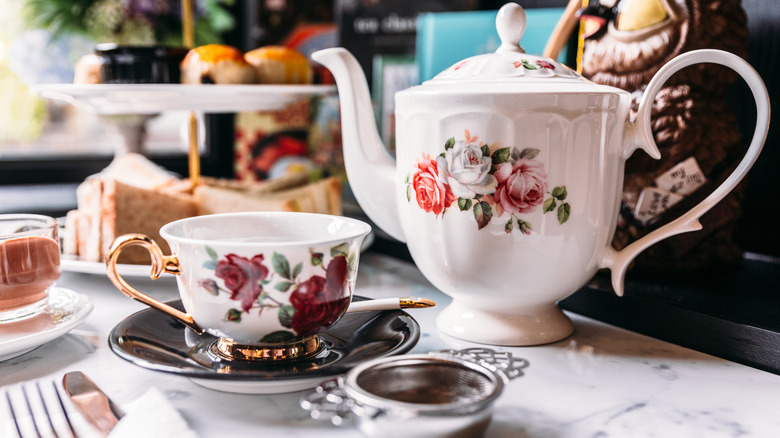The Common Household Ingredient That May Save Your Stained Porcelain
Porcelain dinnerware has been a worldwide phenomenon since as early as the 16th century, though it had been exported from China to other areas of Asia as early as the 10th. Its delicate weight and pristine artistry is revered by those who own it; it's often passed down in families from generation to generation. Over time, that porcelain surface can sustain dozens of tiny little cracks –- the inevitable "wear and tear" of repeated use -– and unfortunately, those cracks may stain from the miniscule particles that seep inside. This is where your pantry can actually help you. Baking soda, made into a soft paste, can help remove stains from your porcelain to help keep it looking newer longer.
Baking soda is one of those DIY remedies proven to successfully tackle many household tasks. It's a powerful deodorizer, a fire extinguisher, a scrubber, a polisher, and an excellent whitener. Whenever you're in a pinch (even if you just ran out of toothpaste), whatever kind of mess you're facing, there's a chance baking soda could be a solution. It should be no surprise, then, that baking soda works wonders on the fragile white porcelain of your family heirlooms.
How to get stains out of porcelain with baking soda
To clean stains out of the frail material that is porcelain, you're going to want to turn your baking soda into a paste. All it takes to do this is a little water –- 1 tablespoon for every 2 tablespoons of baking soda should work, making the paste thick but still spreadable. Because porcelain is a sort of glass-ceramic hybrid, made of clay particles but with a glass-like glazing that is extremely breakable, it needs very careful handling. Apply the paste with a super-soft non-abrasive sponge or microfiber cloth to prevent any scratching, then allow the paste to sit. Check your porcelain after a few seconds (or minutes for old, pesky stains), rinsing off the paste and reapplying if you aren't yet satisfied with the level of whitening yet.
Baking soda does create a mildly abrasive reaction when used as a cleanser, breaking down and buffing away the tiny particles that have embedded into the surface. It's not acidic -– it's actually the opposite, a base –- but the compound is still a tiny bit caustic, eating away at what's there. However, when added to water, it's not creating an acid-base reaction like it is with vinegar, so it's still acting very gently. Essentially, it's that perfect sweet spot of powerful yet gentle.
Good for sinks, tubs, tiles, and more
A baking soda paste is also a great way to get stains out of your porcelain sinks, tubs, or even your tile floors. However, because these surfaces are meant for more rigorous use than fancy dinnerware or collectibles, they can (and should) be cleaned with a tougher mixture. You might use a solvent like vinegar, ammonia, or hydrogen peroxide instead of water to make for a more intense chemical reaction for tougher stain removal and increased disinfection.
For these larger surfaces, the easiest way to eradicate stains is to sprinkle the baking soda over the entire area and then apply the liquid component with a reusable spray bottle from a local discount store for about $1. The two will congeal into a paste upon contact and then react as intended. You can scrub away all the dirt, grime, and stains. Then rinse it down the drain in your sink or tub, or mop it up with a simple wet rag along your porcelain tile. Use another cloth to wipe everything dry, and enjoy your sparkling clean porcelain surfaces.


